Global Plant-Based Protein Beverages industry sales reached approximately USD 1,372.1 Million at the end of 2025. Forecasts suggest the global plant-based protein beverages will achieve a 9.6% compound annual growth rate (CAGR) and exceed USD 2,689.3 Million in value by 2035.
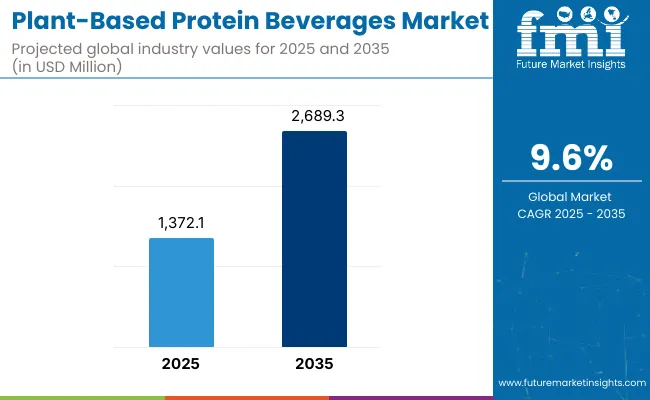
On a global scale, there are several reasons attributed to the growth usage of plant-based protein beverages. Changes in consumer attitudes to diet and the identified correlation between the consumption of animal protein and diseases also contributed to creating a new range of plant-based proteins to meet the needs of increased health-conscious consumers.
Environmental factors also count; consumers are much more alarmed about the environment and the impact of animal farming and usually look for environment-friendly products. However, trends such as veganism and vegetarianism have increased the demand in plant base products.
Manufacturers are adapting to this by introducing new products into the industries through using such plant-based sources as peas, almonds, and soy. Organic food companies will be improving the taste and quality aspects of food to be able to penetrate many segments. Advertising strategies and the establishment of partnerships with additional health-conscious grocery stores also increase awareness and access effectively satisfying the growing consumer demand for these beverages.
The table below shows a comparison of the changing CAGR between the base year, 2024, and the current year, 2025 on a global scale. This examination discloses the main changes in how a is working and shows revenue realization patterns which give stakeholders a better understanding of what this growth trajectory will be like for one year. The first half (H1) is from January through June while the second half (H2) comprises July through December.
| Particular | Value CAGR |
|---|---|
| H1 2024 | 9.4% (2024 to 2033) |
| H2 2024 | 9.8% (2024 to 2033) |
| H1 2025 | 9.5% (2025 to 2034) |
| H2 2025 | 10.0% (2025 to 2034) |
The above table shows the anticipated CAGR in the global Plant-Based Protein Beverages segment for a semi-annual interval between 2025 and 2035. The business is likely to grow at a CAGR of 9.4% in H1 2024, then the growth rate a little bit faster at 9.8% in H2 of the same year.
Moving into the year 2025, CAGR is expected to slightly increase to 9.5% in H1 and remain somewhat steady at 10.0% in H2.In the first half (H1 2025) there was a slight increase in BPS while during the second half (H2 2025), there was a rise in BPS.
New Technologies that improve methods of extracting plant proteins
Technological developments that have been reported in the recent past have greatly changed the extraction methods of plant proteins for drinks. Protein producers are now applying new modes of processing like enzymatic hydrolysis and membrane filtration which will improve the yield and quality of the proteins.
These changes facilitate better extraction from products such as peas, chickpeas, and hemp thereby producing quality protein-based drinks. Dreams’ better processing also ensures that the nutrient content and taste of the product are preserved, an earlier drawback that posed a problem to the consumers.
Also, these technologies allow the inclusion of functional compounds, vitamins, and minerals enhancing the health appeal of these products. Therefore the manufacturers of products can develop various products which can suit their customers’ dietary requirements and thus satisfy more people.
This technological advancement not only brings improvements to the quality of the product but also helps in creating sustainability as most of the resources available are efficiently used and reduced wastage is experienced hence responding to the changing consumer trends which are shifting towards the green industries.
The Veganism trend is on the rise to grow Plant-based Beverages Demand.
The shift in consumers’ behavior towards veganism affects the demand for plant-based protein drinks. It has become a trend in recent years for most, if not all consumers, to adopt a plant-based diet due to health, ethics, or environmental aspects hence a sure bet.
This trend is widespread among young people, and slowly but progressively other people, who care about the environment and animals. This makes plant-based products go mainstream, and influences help spread veganism throughout social media platforms.
Therefore, manufacturers are initiating new products that offer different tastes and formulations to address the differing tastes. Furthermore, campaigns on the positive impacts of taking plant-based products are extending consumer’s knowledge of similar diets.
This awakening is fostering innovation in the sector through the elaboration of fortified drinks that make delivery of needed nutrients feasible, appealing to both vegans and flexitarian consumers including the health-conscious ones.
Sports Nutrition Segment Getting into Plant Base Protein Drink
Currently, the sports nutrition segment is gradually paying attention to plant-based protein in the form of beverages. Such products are now adopted by athletes and the fitness-conscious due to their nutritional attribute which contains amino acid and antioxidants.
Additionally, plant-based protein sources like peas and brown rice to replace conventional whey protein are used, which will suit emerging health-conscious consumers. In addition, these beverages are easy to handle physically and do not trigger cases of stomach upset, which more often warrants a perfect companion for a post-workout drink.
Global Plant-Based Protein Beverages increased at a CAGR of 9.3% from 2020 to 2024. Projections are that expenditure on Plant-Based Protein Beverages will rise at 9.6% CAGR.
From the year 2020 to 2024, with increasing consumer interest in healthy and sustainable products, manufacturers across the globe have started launching new flavors and enhanced nutrient-content plant-based protein drinks. Other growing trends in this segment are increased transparency sourcing through environmentally friendly packaging and fortified products targeting specific diets. These opportunities can also be distributed through various distribution avenues as well as well calculated partnerships to get at the different consumer segment.
For the next ten years (2025 to 2035), manufacturers of global protein beverages based on a plant are emphasizing personalized nutrition, clean-label ingredients, and sustainable packaging. This is while most consumers desire opportunities for expansion and collaboration across various retail channels, focusing more on flourishing benefits and flavors.
Some of the leading brands inside the plant-based protein beverages sector are established brands such as Almond Breeze, Silk, and Oatly. These firms use effective supply chains and demand through the use of brands that can captivate consumers.
They target innovation; fortification and new flavors to meet the nutritional needs of the consumers. Their passion for sustainability and sourcing from the right quarters also place them in a vantage position viewed against the backdrop of the growing increase of people’s preference to plant-based products.
Other companies like Sotexpro, and Pacific Foods in the plant-based protein beverage are capturing segments by focusing not only on local ingredients but also flavors. Such brands are focused on limited production and using local sourcing to attract consumers who are interested in authentic products.
And being focused on specialized segments and products they establish a definite relationship with such highly conscious consumers. They can easily follow trends since they provide new options that are close to the heart of some regions' consumers' diets.
The table below highlights revenue from product sales in key countries. The United States and China are predicted to remain top consumers, with estimated valuations of USD 439.8 Million and USD 513.8 Million, respectively, by 2035.
| Countries | Value (2035) |
|---|---|
| United States | USD 439.8 Million |
| Germany | USD 313.9 Million |
| Japan | USD 133.2 Million |
| China | USD 513.8 Million |
| India | USD 266.1 Million |
The following table shows the estimated growth rates of the top three industries. China and India are set to exhibit Instant cereal consumption, recording CAGRs of 13.4% and 16.3%, respectively, through 2035.
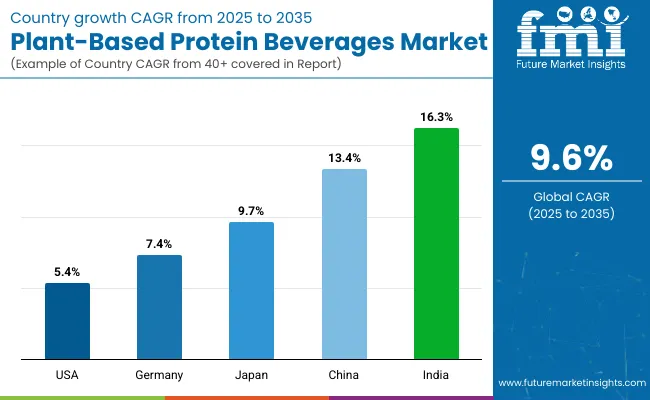
| Countries | CAGR 2025 to 2035 |
|---|---|
| United States | 5.4% |
| Germany | 7.4% |
| Japan | 9.7% |
| China | 13.4% |
| India | 16.3% |
The sale of Plant-Based Protein Beverages in the United States is projected to exhibit a CAGR of 5.4% during the assessment period by 2035, and revenue from these sales is expected to reach USD 439.8 Million.
With the increasing proportion of the vegan-based diet contributing to the volume of the American population, the consumption of plant-based protein beverages has received tremendous momentum. People who have a vegan diet policy in various aspects like health, ethical, or even environmental aspects are always looking for an alternative to consume products that satisfy their veganism.
This has influenced manufacturers to intensify competitiveness and expand differentiation into various forms of products with different flavors and formulations with some ingredients such as pea, almond, and oat protein.
Manufacturers are also adding nutrient dials to boost the overall nutritional values of the food products by incorporating vitamins, minerals, and other functional added advantage to attract the still-growing health-conscious population. The partnerships with the health food stores and fitness clubs also increase the possibilities.
The demand in Germany is expected to rise at a value CAGR of 7.4% during the forecast period 2025 to 2035. By 2035, Germany is expected value share to account for 2.1% of plant-based protein beverages sales in Europe.
The manufacturers in Germany are growing keen to meet this need by coming up with plant-based protein drinks in the country. Their work involves weighing up locally available, high-quality such as peas, hemp, and quinoa, for maximum freshness and sustainability of the ingredients. Innovation of products is what is on most manufacturers' priority lists. The innovative formulation has also been tested on the various dietary needs and flavor requirements of most people.
Many brands focus on clean ingredient labeling to promote transparency and health benefits to attract the discerning consumer. Partnerships with local farmers and research institutions have also improved the quality and nutritive value of their products. Marketing emphasizes how plant-based diets are environmentally friendly, and this is appealing to eco-conscious consumers. Therefore, with these trends, German manufacturers have been tapping into the rising demand for nutritious and sustainable beverage options.
Consumption of Plant-Based Protein Beverages in China is expected to increase at a value CAGR of 13.4% over the next ten years. By 2035, the sale size is forecasted to reach USD 513.8 Million, with China expected to account for a market share of 67.5% in East Asia.
Increased disposable income among Chinese consumers promotes spending on health products including plant-based protein beverages. Increasing disposable income makes consumers health-conscious, and they seek to have healthy drinking options that are always congruent with their wellness goals. This has prompted manufacturers to introduce new products and line extensions customizable to different flavors and formulation profiles unique to localities.
Brands have developed their quality ingredients into functional benefits like energizing and digestive support to lure health-oriented shoppers. Additionally, marketing tactics used must include features that explain the benefits of plant-based diets such as sustainability and nutrition.
As demand rises, translations of the characteristics of health and wellness will bring the same in bringing consumer attention towards plant-based protein beverages, subsequently pushing manufacturers to extract more from this sector by widening their reach toward the healthy conscious.
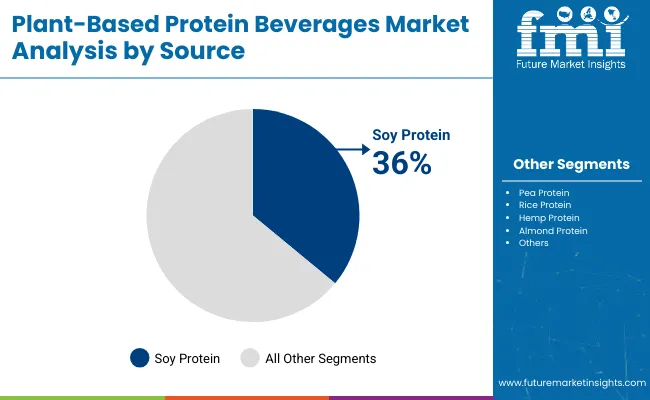
| Segment | Soy Protein (Source) |
|---|---|
| Value Share (2025) | 35.7% |
Sales of soy protein source is projected to register a CAGR of 8.3% from 2025 to 2035
Soy protein is the most extensive product in the category of plant-protein beverages and a significant advantage for both producers and consumers. Soy protein is inexpensive and easily accessible which makes it ideal for use by manufacturing firms in their products.
It can be conveniently utilized in a broad spectrum of applications and is compatible with diverse forms including liquid and powder ingredients, smoothies, RTD liquids, and products. Also, it is rich in amino acids, demonstrating a balanced protein pan, which will appeal to consumer needs with their health, as it contains good protein.
Beverages made from soy-based proteins hold good status among consumers in terms of nutrition, which includes heart health and possible weight loss as well. Further, soy is highly endowed in isoflavones and thus has antioxidant properties, adding to the very appeal of the product.
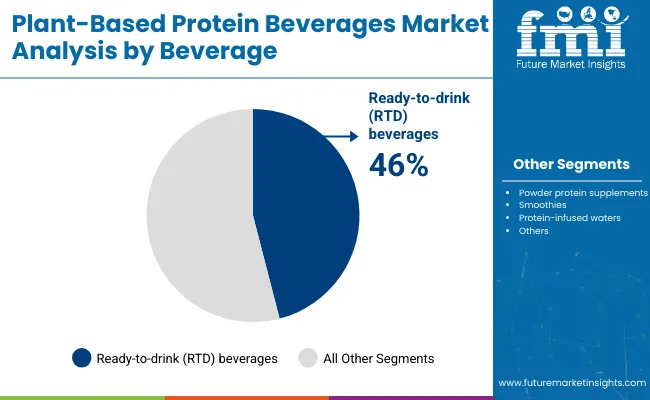
| Segment | Ready-to-drink (RTD) beverages (Type of Beverage) |
|---|---|
| Value Share (2025) | 46.3% |
The rapidly growing popularity of the capsule form is anticipated to advance at 8.7% CAGR during the projection period.
The trends in the Ready-to-drink (RTD) beverages are very high for numerous specifications, which in one way, exaggerate the demand as opposed to other forms of beverages. This is especially a major reason; consumption patterns have shifted to accommodate ease in the convenience of the day and busy lives. RTD beverages are very ideal for this because they provide portable, on-the-go mechanizations for daily schedules.
However, the main factors are health consciousness and population aging. The consumers also want to consume RTD beverages that contain low quantities of sugar, and high quantities of nutrients that are good for the body in the current world of well-being. These trends compel manufacturers to develop new products of different flavors and formulations to suit individual tastes, preferences, and use of organic and plant-based ingredients.
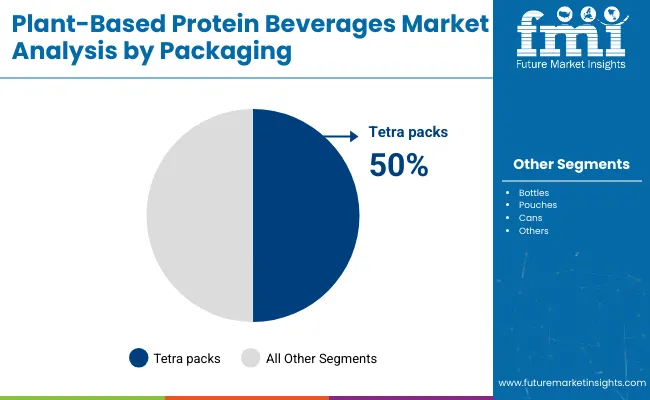
| Segment | Tetra packs (Packaging Type) |
|---|---|
| Value Share (2025) | 49.7% |
The rapidly growing tetra pack packaging type is anticipated to advance at 9.1% CAGR during the projection period.
Tetra packs have subsequently gained popularity as plant-based protein beverages for several reasons. The beverages’ ability to afford the best barrier protection against light, air, and moisture ensures that those beverages are fresh and rich in nutritional properties for a more extended period.
This is especially so in the products that one may have ingredients that are wrongly perceived by the public. Further, Tetra packs allow consumers to get ready to drink beverage products easily, especially the energetic and overly busy populace that prefers such products. It also rises in a very convenient way and has a twist top making it easy to pour and reseal when closed.
Further, Tetra packs are cost-friendly in that they are usually made from renewable resources and are also recycled. This is in line with the preferences of the new generation consumer who is more environmentally inclined. Moreover, the use of graphics on Tetra packs enhances the communication of brand-specific information and may equally positively influence consumers’ perception of products.
Some of the major industries that are functioning on the global scale include Kerry Group, Malk Organic, Archer Daniels Midland Company, Axiom Foods Inc., Califia farms, ALOHA, Ripple Foods, Sotexpro, The New Barn, Dr. McDougall’s Right Foods, and among others. The current key player's strategy includes product differentiation.
Due to the intrinsic versatility of applying Plant-Based Protein Beverages, many key manufacturers are grappling with it to identify other uses of the product since its health-protecting capability is virtually unrivaled.
Recent Developments
By Source, the segment has been categorized as Soy Protein, Pea Protein, Rice Protein, Hemp Protein, Almond Protein, and Other plant sources (e.g., pumpkin seed, sunflower seed).
Different Types of Beverages include Ready-to-drink (RTD) beverages, Powder protein supplements, Smoothies, and Protein-infused waters.
By Flavor, the segment has been categorized as Unflavored, Chocolate, Vanilla, Fruit-flavored, and Coffee or mocha.
Different Packaging Types are included in the segments such as Tetra packs, Bottles, Pouches, and Cans.
Different Distribution Channels are included in the segments such as online retail, Super & Hypermarkets, Health food stores, Specialty stores, and Gyms & Fitness Centers.
Regional analysis has been carried out in key countries of North America, Latin America, Western Europe, Eastern Europe, Balkans & Baltic, Russia & Belarus, Central Asia, East Asia, South Asia & Pacific, Middle East & Africa.
The global Acne Supplement sales are estimated at a value of USD 1,372.1 Million in 2025.
Kerry Group, Malk Organic, Archer Daniels Midland Company, Axiom Foods Inc., Califia farms, ALOHA, and other manufacturers of Plant-Based Protein Beverages.
The North American sector is projected to hold a revenue share of 29.5% over the forecast period.
Europe holds an 18.8% share of the global industries for Plant-Based Protein Beverages.






Our Research Products

The "Full Research Suite" delivers actionable market intel, deep dives on markets or technologies, so clients act faster, cut risk, and unlock growth.

The Leaderboard benchmarks and ranks top vendors, classifying them as Established Leaders, Leading Challengers, or Disruptors & Challengers.

Locates where complements amplify value and substitutes erode it, forecasting net impact by horizon

We deliver granular, decision-grade intel: market sizing, 5-year forecasts, pricing, adoption, usage, revenue, and operational KPIs—plus competitor tracking, regulation, and value chains—across 60 countries broadly.

Spot the shifts before they hit your P&L. We track inflection points, adoption curves, pricing moves, and ecosystem plays to show where demand is heading, why it is changing, and what to do next across high-growth markets and disruptive tech

Real-time reads of user behavior. We track shifting priorities, perceptions of today’s and next-gen services, and provider experience, then pace how fast tech moves from trial to adoption, blending buyer, consumer, and channel inputs with social signals (#WhySwitch, #UX).

Partner with our analyst team to build a custom report designed around your business priorities. From analysing market trends to assessing competitors or crafting bespoke datasets, we tailor insights to your needs.
Supplier Intelligence
Discovery & Profiling
Capacity & Footprint
Performance & Risk
Compliance & Governance
Commercial Readiness
Who Supplies Whom
Scorecards & Shortlists
Playbooks & Docs
Category Intelligence
Definition & Scope
Demand & Use Cases
Cost Drivers
Market Structure
Supply Chain Map
Trade & Policy
Operating Norms
Deliverables
Buyer Intelligence
Account Basics
Spend & Scope
Procurement Model
Vendor Requirements
Terms & Policies
Entry Strategy
Pain Points & Triggers
Outputs
Pricing Analysis
Benchmarks
Trends
Should-Cost
Indexation
Landed Cost
Commercial Terms
Deliverables
Brand Analysis
Positioning & Value Prop
Share & Presence
Customer Evidence
Go-to-Market
Digital & Reputation
Compliance & Trust
KPIs & Gaps
Outputs
Full Research Suite comprises of:
Market outlook & trends analysis
Interviews & case studies
Strategic recommendations
Vendor profiles & capabilities analysis
5-year forecasts
8 regions and 60+ country-level data splits
Market segment data splits
12 months of continuous data updates
DELIVERED AS:
PDF EXCEL ONLINE
Instant Protein Beverages Market Analysis by Type, End-Use Packaging, Form, Source and Region Through 2035
Protein-Coating Line Market Forecast Outlook 2025 to 2035
Protein Labelling Market Size and Share Forecast Outlook 2025 to 2035
Protein Puddings Market Size and Share Forecast Outlook 2025 to 2035
Protein/Antibody Engineering Market Size and Share Forecast Outlook 2025 to 2035
Protein Expression Market Size and Share Forecast Outlook 2025 to 2035
Protein Purification Resin Market Size and Share Forecast Outlook 2025 to 2035
Protein Hydrolysate For Animal Feed Application Market Size and Share Forecast Outlook 2025 to 2035
Protein Crisps Market Outlook - Growth, Demand & Forecast 2025 to 2035
Protein Hydrolysate Market Size and Share Forecast Outlook 2025 to 2035
Protein Supplement Market - Size, Share, and Forecast 2025 to 2035
Protein Powder Market Analysis - Size, Share, and Forecast Outlook 2025 to 2035
Protein Purification and Isolation Market Insights – Size, Share & Forecast 2025 to 2035
Protein Ingredients Market Analysis - Size, Share, and Forecast 2025 to 2035
Protein A Resins Market Trends, Demand & Forecast 2025 to 2035
Proteinase K Market Growth - Trends & Forecast 2025 to 2035
Proteinuria Treatment Market Insights – Demand & Forecast 2025 to 2035
Protein Packaging Market Trends and Forecast 2025 to 2035
Analysis and Growth Projections for Protein Hydrolysate Ingredient Market
Protein Shot Market Analysis by Packaging, Distribution Channel, Product Claims and Regions Through 2035

Thank you!
You will receive an email from our Business Development Manager. Please be sure to check your SPAM/JUNK folder too.
Chat With
MaRIA